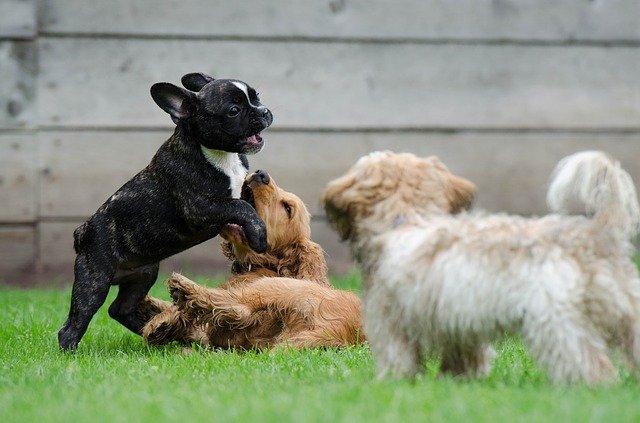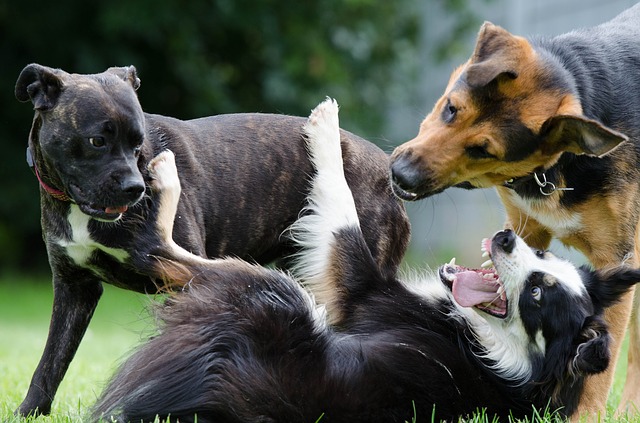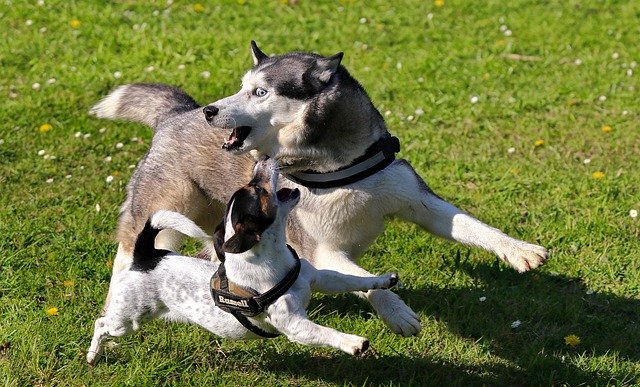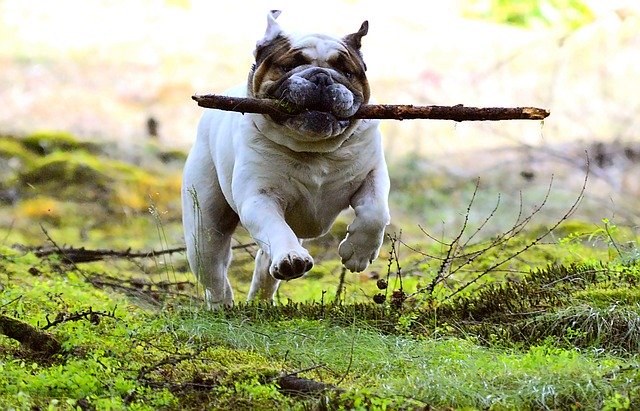How to understand the game between dogs? It is often difficult for handlers to identify if the dogs present are playing or if they are pressuring each other and then the game ends in a fight.
Clearly, it is the identification of the different signals as well as their interpretation that is sometimes complex. I therefore suggest you here to understand how dogs play with each other, how to identify the signals that could require your intervention from those which demonstrate, on the contrary, a good balanced play session and therefore the need for you to erase yourself completely.

What is the use of dog play?
First of all, it is important to understand why it is necessary to let dogs or puppies play with each other and what benefits they derive from these exchanges.
Meeting the dog’s social needs
Play is essential and part of the dog’s social needs. It is a healthy and useful activity that is part of the interactions that dogs should have with their peers.
The game should be a moment of pleasure, as much for the owners as for the dogs between them. We will see later on how to make sure that a dog play session goes well.
The game is for dog to dispense its energy, as we have seen, but also to create and / or strengthen the links between two (or more) dogs. It is therefore an activity that it is important to offer while being careful with the dogs that are introduced into the play session.
In fact, we will not let two dogs with very distant sizes play together, just as we will avoid leaving a puppy full of energy in demand for play with an adult dog, or even senior dog who no longer has too much patience.
Reinforce dog learning
In addition, the game allows, mainly for puppies, to learn and / or reinforce the various dog codes as well as learning such as bite inhibition or self-checks for example.
It will also be very interesting to have a puppy and an adult dog play together (very balanced and coded) so that he can “put back in place” the puppy if he goes too far in his requests for play and play. ‘Warning. This will allow the puppy to understand the limits that must not be crossed and therefore learning to self-control will only be reinforced.
In addition, the game has a real educational function because when they play with each other, they mainly use the game to learn. Indeed, the game allows them to learn what is known as bite inhibition: learning how to control and how strong they have in their jaw.
Then, for adult dogs, play allows them quite simply, not to create but to reinforce their canine codes, and therefore, more generally, their intra-specific communication (between dogs).

Recognize the signals of a dog calling for play:
A dog who wants to play will not beat around the bush, his attitude will be very clear and to indicate his state of excitement and his desire to play, he will adopt a very specific posture: the forelegs lowered forward and the posterior raised (as on the photo below). One could liken this position to a curtsy. Many owners want to teach their dog like a trick, the famous “hello”.
Recognize the signals of a dog that does not want to play:
On the other hand, we can also develop here the signals sent by dogs to avoid play precisely, we call this signals of appeasement. Because yes, despite the insistent requests of a dog X, it may be that the dog Y clearly does not want to play and will know how to make it understood: he will turn his head away, or have an attitude of flight, or possibly use a few growls if he can’t make himself understood from the start.
Clearly, a dog who does not want to play has three options:
• He waits for it to happen (by sending calming signals to the other dog)
• It leaks (to avoid contact)
• He attacks (and we’ll see how to prevent that from happening)
Signals
The signals that a dog can send will therefore go “crescendo”, depending on whether the dog in front understands them or not:
1. The dog who does not want to play will have a fairly static attitude, relatively rigid, will have the mouth closed and the coat possibly bristling. Above all, do not be fooled by the movement of the tail as it can just as easily be raised / static as it is moving very fast: this will mean in any case that the dog is not in a comfortable situation.
2. Alternatively, the dog is very uncomfortable with this situation, to the point of being anxious and this will result in a low head, a round back and the tail between the legs.
3. The dog in front does not understand the calming signals sent by the uncomfortable dog. The latter will therefore have no other choice but to warn his “buddy” a little more forcefully that gambling will not be an option in this interaction. There will therefore be grunts, visible teeth, nose licking, jaw snapping (bite into the void), etc.
When should the teacher intervene?
I’m not saying that you must intervene as soon as there is a growl (especially not, for that matter, because the growl can mean excitement in the game without necessarily coming aggression), you simply have to intervene as soon as you observe that the ‘one of the dogs does not receive the codes and signals sent by the other dog.
To intervene, you just have to divert your dog to another activity. Hence the need here to have a basic obedient dog, without too many distractions, to manage to get him out of a very stimulating situation for him.
Don’t hesitate to read our articles on learning the basics
“We play brawl”
The dog play sessions often seem very impressive because we see teeth, we hear grunts and we tell ourselves that there is still a form of fight underneath … and yet … And yet, yes, that’s it, dogs “play” looks like a brawl! They train for the times when they really need to get started … No kidding aside, yes, dogs have different “types” of play:
The fight
There is the lying wrestling and the standing wrestling. You will especially see the prone wrestling in puppies among themselves as well as in dogs who already know each other very well because the lying position remains one of the most vulnerable postures for a dog. In addition, be careful if the fight starts to become vertical, in clear if the two dogs are standing on their two hind legs, this can lead to a possible attack if one of the two dogs or both are not well coded. “.

Hunting (pursuit races)
It is very often that we see dogs chasing each other. Be careful, however, that one of the dogs does not get chased by several dogs for too long. Moreover, during these chases, it is important to carefully observe if all the dogs present are OK with the game and do not suffer it!
In order for a playing session to go well, whether it’s wrestling or chasing, it is important that the roles are reversed from time to time. If you observe this, worry no more, that everything is going well.
To summarize :
In general, the playing sessions go off without a hitch, and it is often the intervention of the masters that causes difficulties.
The master must therefore have a fairly neutral attitude, fairly withdrawn, while observing the signals of all the dogs present and must be able to intervene if one of the dogs cannot get out of an uncomfortable situation, which could lead to a (real) fight.
Next, it is important to ensure that all dogs have good codes but also that they can read, receive and accept those of the other dogs present.
Indeed, a game that goes badly is often caused by a non-respect of dog codes, a non-compliance with appeasement signals and / or a non-compliance with requests to stop the game. And this is where the intervention of the master will be necessary and important to divert each dog to a different activity.
Clearly, balanced dogs (with good canine codes) and of the same size and energy as well as serene masters (who do not intervene every two seconds with each growl) will be the perfect ingredients for good dog play sessions!

